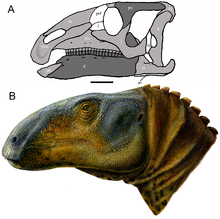| Eolambia Temporal range: Cenomanian,
| |
|---|---|

| |
| Skull reconstruction (A) and life restoration (B) | |
| Scientific classification | |
| Domain: | Eukaryota |
| Kingdom: | Animalia |
| Phylum: | Chordata |
| Clade: | Dinosauria |
| Clade: | †Ornithischia |
| Clade: | †Neornithischia |
| Clade: | †Ornithopoda |
| Superfamily: | †Hadrosauroidea |
| Clade: | †Hadrosauromorpha |
| Genus: | †Eolambia Kirkland, 1998 |
| Type species | |
| †Eolambia caroljonesa Kirkland, 1998
| |
Eolambia (meaning "dawn lambeosaurine") is a genus of herbivorous hadrosauroid dinosaur from the early Late Cretaceous of the United States. It contains a single species, E. caroljonesa, named by paleontologist James Kirkland in 1998. The type specimen of Eolambia was discovered by Carole and Ramal Jones in 1993; the species name honors Carole. Since then, hundreds of bones have been discovered from both adults and juveniles, representing nearly every element of the skeleton. All of the specimens have thus far been found in Emery County, Utah, in a layer of rock known as the Mussentuchit Member of the Cedar Mountain Formation.
Measuring up to 6 meters (20 ft) long, Eolambia is a large member of its group. While it closely approaches the Asian hadrosauroids Equijubus, Probactrosaurus, and Choyrodon, in traits of the skull, vertebrae, and limbs, it may actually be more closely related to the North American Protohadros. This grouping, based on the straightness of the quadrate bone and scapula, would represent an isolated, endemic radiation of hadrosauroids. Despite resembling hadrosaurids – lambeosaurine hadrosaurids in particular – in several features, leading to its initial identification as one of them, these similarities have been rejected as either entirely convergent or misinterpreted.
Eolambia would have lived in a forested environment at the edge of lakes in a humid floodplain environment, feeding on gymnosperms, ferns, and flowering plants. The water levels in the lakes changed over time with cyclical wet and dry spells caused by the precession of the Earth, reflected by alternating bands in the sediments of the Mussentuchit Member. As a juvenile, Eolambia would have been preyed upon by large crocodylomorphs residing in the lake waters. With increasing age, however, they became impervious to the crocodylomorphs, and mature individuals (at least eight to nine years in age) were preyed on by large theropods such as the neovenatorid Siats.